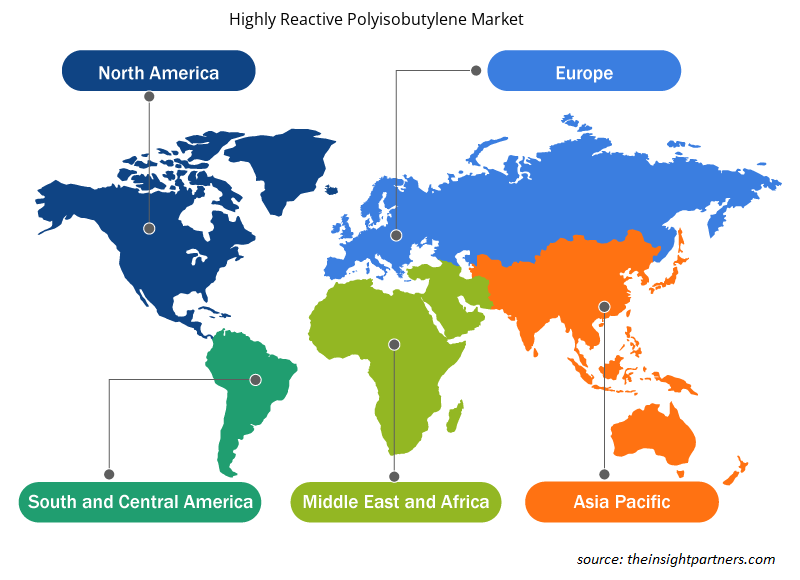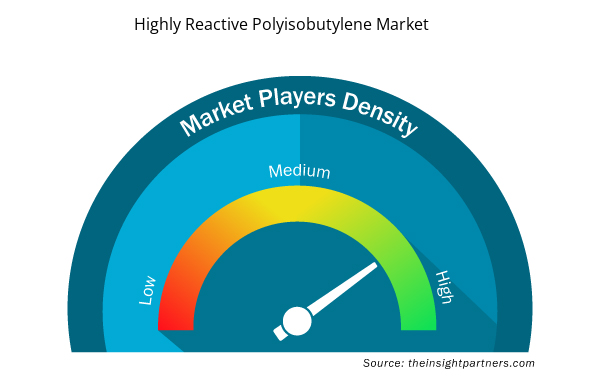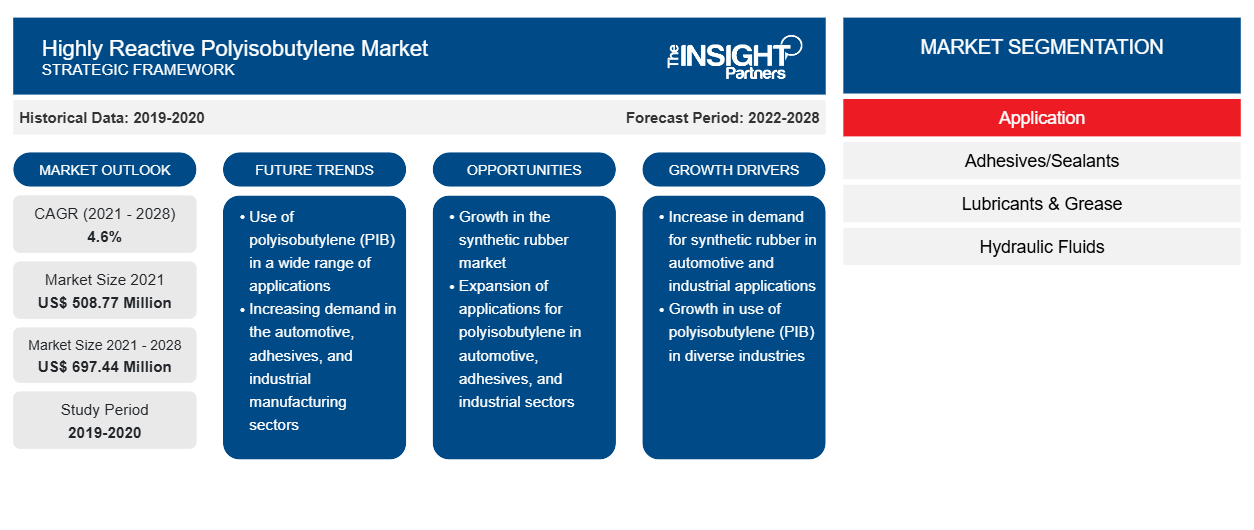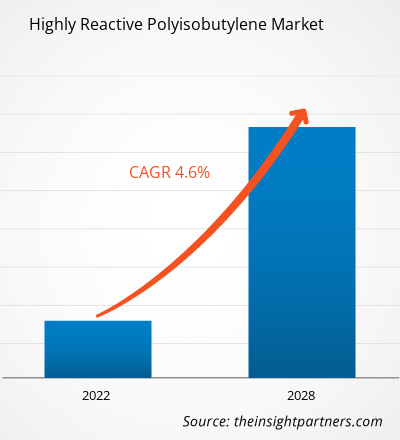Si prevede che il mercato del poliisobutilene altamente reattivo raggiungerà i 697,44 milioni di dollari entro il 2028, rispetto ai 508,77 milioni di dollari del 2021; si prevede che crescerà a un CAGR del 4,6% dal 2021 al 2028.
Il poliisobutilene altamente reattivo (HR-PIB) è un importante intermedio utilizzato nella produzione di additivi per carburanti e lubrificanti ad alte prestazioni, come disperdenti per oli motore o detergenti per carburanti. Gli additivi per lubrificanti ad alte prestazioni consentono progetti di motori più efficienti in termini di consumo di carburante.
Nel 2020, l'Asia Pacifica ha detenuto la quota di fatturato maggiore del mercato del poliisobutilene altamente reattivo . Il segmento dei lubrificanti e dei grassi è il maggiore consumatore di HR-PIB nella regione Asia Pacifica. La proliferazione del settore automobilistico nella regione sta aumentando la domanda di fluidi idraulici e lubrificanti, spingendo così la necessità di HR-PIB. Inoltre, l'aumento dell'industrializzazione e dell'edilizia nell'Asia Pacifica sta guidando la domanda di macchinari e attrezzature nelle strutture di produzione correlate.
Personalizza questo report in base alle tue esigenze
Riceverai la personalizzazione gratuita di qualsiasi report, comprese parti di questo report, o analisi a livello nazionale, pacchetto dati Excel, oltre a usufruire di grandi offerte e sconti per start-up e università
- Scopri le principali tendenze di mercato in questo rapporto.Questo campione GRATUITO includerà analisi di dati che spaziano dalle tendenze di mercato alle stime e alle previsioni.
Impatto della pandemia di COVID-19 sul mercato del poliisobutilene altamente reattivo
Nel 2020, vari settori hanno dovuto rallentare le proprie attività a causa di interruzioni nelle catene di fornitura causate dalla chiusura dei confini nazionali e internazionali, che hanno portato a una bassa domanda di HR-PIB. La pandemia ha causato interruzioni nei processi di produzione a causa delle restrizioni imposte dalle autorità governative in vari paesi sul personale nei reparti di lavoro e sui trasporti, il che ha reso difficile per i dipendenti spostarsi da e verso i luoghi di lavoro. HR-PIB trova importanti applicazioni nella produzione di additivi per carburanti e lubrificanti ad alte prestazioni. La diminuzione della domanda di carburante da parte di vari settori ha ostacolato il consumo di additivi per carburanti, ostacolando infine le vendite di HR-PIB. Tuttavia, quando le economie hanno iniziato a rilanciare le proprie attività nel 2021, anche la domanda di HR-PIB ha iniziato a crescere gradualmente.
Approfondimenti di mercato
Utilizzo crescente di HR-PIB nella produzione di additivi per carburanti e lubrificanti ad alte prestazioni
L'HR-PIB è un importante intermedio che trova applicazione nella produzione di is an important intermediate that finds application in the production of high-performance fuel and additivi per carburanti e lubrificanti ad alte prestazioni . Grazie alla sua natura altamente reattiva, è preferito al poliisobutilene convenzionale nella produzione di additivi. La funzione principale degli additivi per lubrificanti è quella di migliorare le proprietà della base in diverse condizioni operative. Inoltre, gli additivi per lubrificanti ad alte prestazioni supportano progetti di motori più efficienti in termini di carburante. I disperdenti sono additivi per lubrificanti che aiutano a prevenire la formazione di fanghi, vernici e altri depositi su superfici critiche. La domanda di HR-PIB sta crescendo nella sintesi industriale di disperdenti per oli motore per autoveicoli. La presenza di solide basi di produzione di additivi negli Stati Uniti, in Europa e nell'Asia Pacifica li rende i principali consumatori di HR-PIB. Quindi, il crescente utilizzo di HR-PIB nella produzione di additivi per carburanti e lubrificanti ad alte prestazioni stimola la crescita del mercato.polyisobutylene in the production of additives. The main function of lubricant additives is to improve the properties of the base stock under different operating conditions. Moreover, high-performance lubricant additives support more fuel-efficient engine designs. Dispersants are lubricant additives that help prevent sludge, varnish, and other deposit formation on critical surfaces. The demand for HR-PIB is growing in the industrial synthesis of dispersants for automotive engine oils. The presence of strong additive manufacturing bases in the US, Europe, and Asia Pacific makes them prime consumers of HR-PIB. Hence, the increasing use of HR-PIB in the manufacturing of high-performance fuel and lubricant additives boosts the market growth.
Approfondimenti sulle applicazioni
In base all'applicazione, il mercato del poliisobutilene altamente reattivo è stato segmentato in adesivi/sigillanti, lubrificanti e grassi, fluidi idraulici, fluidi per la lavorazione dei metalli e altri. Il segmento dei lubrificanti e dei grassi ha detenuto la quota di mercato maggiore nel 2020. Lubrificanti come oli motore, oli per trasmissioni, oli per ingranaggi, grassi e oli per compressori sono ampiamente consumati nei settori automobilistico, aeronautico, marittimo e dei macchinari. HR-PIB aiuta a migliorare le prestazioni complessive dei lubrificanti.polyisobutylene market has been segmented into adhesives/sealants, lubricants & grease, hydraulic fluids, metal working fluids, and others. The lubricants & grease segment held the largest market share in 2020. Lubricants such as engine oils, transmission oils, gear oils, greases, and compressor oils are highly consumed in the automotive, aircraft, marine, and machinery industries. HR-PIB helps enhance the overall performance of lubricants.
TPC Group; RB PRODUCTS INC.; BASF PETRONAS Chemicals Sdn. Bhd; Shandong Hongrui New Material Technology Co., Ltd; Daelim Co., Ltd.; Chevron Corporation; The Lubrizol Corporation; KEMAT Polybutenes; Weifang Binhai Petro-chem Co., Ltd.; e Nelson Brothers Incorporated sono tra i principali attori del mercato del poliisobutilene altamente reattivo. Gli attori che operano nel mercato del poliisobutilene altamente reattivo sono fortemente concentrati sullo sviluppo di prodotti innovativi e di alta qualità per soddisfare i requisiti del cliente. Group; RB PRODUCTS INC.; BASF PETRONAS Chemicals Sdn. Bhd; Shandong Hongrui New Material Technology Co., Ltd; Daelim Co., Ltd.; Chevron Corporation; The Lubrizol Corporation; KEMAT Polybutenes; Weifang Binhai Petro-chem Co., Ltd.; and Nelson Brothers Incorporated are among the key market players in the highly reactive polyisobutylene market. Players operating in the highly reactive polyisobutylene market are highly focused on the development of high-quality and innovative products to meet the customer’s requirements.
Approfondimenti regionali sul mercato del poliisobutilene altamente reattivoPolyisobutylene Market Regional Insights
Le tendenze regionali e i fattori che influenzano il mercato del poliisobutilene altamente reattivo durante il periodo di previsione sono stati ampiamente spiegati dagli analisti di Insight Partners. Questa sezione discute anche i segmenti del mercato del poliisobutilene altamente reattivo e la geografia in Nord America, Europa, Asia Pacifico, Medio Oriente e Africa e America meridionale e centrale.

- Ottieni i dati specifici regionali per il mercato del poliisobutilene altamente reattivo
Ambito del rapporto di mercato del poliisobutilene altamente reattivo
| Attributo del report | Dettagli |
|---|---|
| Dimensioni del mercato nel 2021 | 508,77 milioni di dollari USA |
| Dimensioni del mercato entro il 2028 | 697,44 milioni di dollari USA |
| CAGR globale (2021 - 2028) | 4,6% |
| Dati storici | 2019-2020 |
| Periodo di previsione | 2022-2028 |
| Segmenti coperti | Per applicazione
|
| Regioni e Paesi coperti | America del Nord
|
| Leader di mercato e profili aziendali chiave |
|
Densità degli attori del mercato del poliisobutilene altamente reattivo: comprendere il suo impatto sulle dinamiche aziendali
Il mercato del poliisobutilene altamente reattivo sta crescendo rapidamente, spinto dalla crescente domanda degli utenti finali dovuta a fattori quali l'evoluzione delle preferenze dei consumatori, i progressi tecnologici e una maggiore consapevolezza dei vantaggi del prodotto. Con l'aumento della domanda, le aziende stanno ampliando le loro offerte, innovando per soddisfare le esigenze dei consumatori e capitalizzando sulle tendenze emergenti, il che alimenta ulteriormente la crescita del mercato.
La densità degli operatori di mercato si riferisce alla distribuzione di aziende o società che operano in un particolare mercato o settore. Indica quanti concorrenti (operatori di mercato) sono presenti in un dato spazio di mercato in relazione alle sue dimensioni o al valore di mercato totale.
Le principali aziende che operano nel mercato del poliisobutilene altamente reattivo sono:
- Gruppo TPC
- PRODOTTI RB INC.
- Società chimica BASF PETRONAS S.p.A.
- Shandong Hongrui New Material Technology Co., Ltd
- Società anonima Daelim Co., Ltd.
Disclaimer : le aziende elencate sopra non sono classificate secondo un ordine particolare.

- Ottieni una panoramica dei principali attori del mercato del poliisobutilene altamente reattivo
Segnala i riflettori
- Tendenze progressive nel settore del poliisobutilene altamente reattivo per aiutare gli operatori a sviluppare strategie efficaci a lungo termine
- Strategie di crescita aziendale adottate dalle aziende per garantire la crescita nei mercati sviluppati e in via di sviluppo
- Analisi quantitativa del mercato del poliisobutilene altamente reattivo dal 2019 al 2028
- Stima della domanda globale di HR-PIB
- Analisi delle cinque forze di Porter per illustrare l'efficacia degli acquirenti e dei fornitori che operano nel settore
- Sviluppi recenti per comprendere lo scenario competitivo del mercato
- Tendenze e prospettive di mercato, e fattori che guidano e frenano la crescita del mercato del poliisobutilene altamente reattivo
- Assistenza nel processo decisionale evidenziando le strategie di mercato che sostengono l'interesse commerciale
- Dimensioni del mercato del poliisobutilene altamente reattivo in vari nodi
- Panoramica dettagliata e segmentazione del mercato e dinamiche del settore HR-PIB
- Dimensioni del mercato del poliisobutilene altamente reattivo in varie regioni con promettenti opportunità di crescita
Mercato del poliisobutilene altamente reattivo
Applicazione
- Adesivi/Sigillanti
- Lubrificante e grasso
- Fluidi idraulici
- Fluidi per la lavorazione dei metalli
- Altri
Profili aziendali
- Gruppo TPC
- PRODOTTI RB INC.
- Società chimica BASF PETRONAS S.p.A.
- Shandong Hongrui New Material Technology Co., Ltd
- Società anonima Daelim Co., Ltd.
- Società Chevron
- La società Lubrizol
- Polibuteni KEMAT
- Società per azioni Weifang Binhai Petro-chem Co., Ltd.
- Fratelli Nelson Incorporated
- Analisi storica (2 anni), anno base, previsione (7 anni) con CAGR
- Analisi PEST e SWOT
- Valore/volume delle dimensioni del mercato - Globale, regionale, nazionale
- Industria e panorama competitivo
- Set di dati Excel


- Lyophilization Services for Biopharmaceuticals Market
- Investor ESG Software Market
- Micro-Surgical Robot Market
- Point of Care Diagnostics Market
- Intraoperative Neuromonitoring Market
- Fertilizer Additives Market
- Electronic Data Interchange Market
- Pipe Relining Market
- Photo Editing Software Market
- Identity Verification Market

Report Coverage
Revenue forecast, Company Analysis, Industry landscape, Growth factors, and Trends

Segment Covered
This text is related
to segments covered.

Regional Scope
North America, Europe, Asia Pacific, Middle East & Africa, South & Central America

Country Scope
This text is related
to country scope.
Domande frequenti
Production techniques and catalysts used to synthesize HR-PIB have become an important subject for research and development activities in the last few decades. Research and development activities are mostly focusing on new polymerization techniques with greater potential advantages than traditional techniques. Various research groups are also actively investigating new catalysts for synthesizing highly reactive polyisobutylene; this further underlines the demand for different polymerization techniques than the existing ones. In addition, HR-PIB is gaining significant popularity in different downstream functionalization reactions due to its greater reactivity than its conventional counterparts. These factors are likely to lead to new future trends in the highly reactive polyisobutylene market.
Players operating in the highly reactive polyisobutylene market are increasingly focusing on ramping up their production capacities to meet future customer demands by making significant investments. They are implementing plans to set up additional capacities of highly reactive polyisobutylene. In 2019, Saudi Aramco and Total announced an agreement with Daelim, a South Korean petrochemical company, to build a new polyisobutylene facility. As per the Memorandum of Understanding (MoU) between these companies, Daelim is planning to build a new state-of-the-art PIB plant with a capacity of 80,000 tons. The new plant is expected to come on-stream in 2024. This specialty chemical project will be using Daelim’s PIB proprietary technology to produce a wide range of products, from conventional PIB (CPIB) to HR-PIB, in a single plant. Hence, the growing focus of market players to escalate their capacities of HR-PIB production will offer huge growth opportunities to the market players in the coming years.
Increasing use of highly reactive polyisobutylene in high-performance fuel and lubricant additive production and proliferation of the automotive sector are the key factors driving the highly reactive polyisobutylene market during the forecast period. Highly reactive polyisobutylene is an important intermediate that finds application in the production of high-performance fuel and lubricant additives, such as fuel detergents or dispersants for engine oils. Due to its highly reactive nature, highly reactive polyisobutylene is preferred over conventional polyisobutylene in additive production. The demand for highly reactive polyisobutylene is growing in the industrial synthesis of dispersants for automotive engine oils. Moreover, highly reactive polyisobutylene finds applications in the production of fuel and lubricant additives, sealants, adhesives, and greases, among others, the flourishment of the automotive sector, in turn, creates a high demand for the same, thereby boosting the market growth.
Based on application, the lubricant and grease segment led the global highly reactive polyisobutylene market in 2020. Lubricants such as engine oils, transmission oils, gear oils, greases, and compressor oils are highly consumed in automotive, aircraft, marine, and machinery industries. highly reactive polyisobutylene is used as an intermediate for lubricant additive manufacturing. It helps to enhance the overall performance of lubricant and grease which is propelling the segment growth.
The major players operating in the global highly reactive polyisobutylene market are TPC Group; RB PRODUCTS INC.; BASF PETRONAS Chemicals Sdn. Bhd; Shandong Hongrui New Material Technology Co., Ltd; Daelim Co., Ltd.; Chevron Corporation; The Lubrizol Corporation; KEMAT Polybutenes; Weifang Binhai Petro-chem Co., Ltd.; and Nelson Brothers Incorporated.
During the forecast period, Asia-Pacific is anticipated to account for the largest share of the global highly reactive polyisobutylene market. Asia-Pacific region comprises several developed and developing economies, including China, India, Japan, South Korea, among others. The region is experiencing significant growth in automotive, which is boosting the demand for hydraulic fluid and lubricants which directly boosts demand for highly reactive polyisobutylene. Further, the increase in industrialization and construction in the region is driving the demand of machineries and equipment for manufacturing facilities, hydraulic fluids and sealants are widely used in these industries.
Trends and growth analysis reports related to Chemicals and Materials : READ MORE..
The List of Companies - Highly Reactive Polyisobutylene Market
- TPC Group
- RB PRODUCTS INC.
- BASF PETRONAS Chemicals Sdn. Bhd
- Shandong Hongrui New Material Technology Co., Ltd
- Daelim Co., Ltd.
- Chevron Corporation
- The Lubrizol Corporation
- KEMAT Polybutenes
- Weifang Binhai Petro-chem Co., Ltd.
- Nelson Brothers Incorporated
The Insight Partners performs research in 4 major stages: Data Collection & Secondary Research, Primary Research, Data Analysis and Data Triangulation & Final Review.
- Data Collection and Secondary Research:
As a market research and consulting firm operating from a decade, we have published and advised several client across the globe. First step for any study will start with an assessment of currently available data and insights from existing reports. Further, historical and current market information is collected from Investor Presentations, Annual Reports, SEC Filings, etc., and other information related to company’s performance and market positioning are gathered from Paid Databases (Factiva, Hoovers, and Reuters) and various other publications available in public domain.
Several associations trade associates, technical forums, institutes, societies and organization are accessed to gain technical as well as market related insights through their publications such as research papers, blogs and press releases related to the studies are referred to get cues about the market. Further, white papers, journals, magazines, and other news articles published in last 3 years are scrutinized and analyzed to understand the current market trends.
- Primary Research:
The primarily interview analysis comprise of data obtained from industry participants interview and answers to survey questions gathered by in-house primary team.
For primary research, interviews are conducted with industry experts/CEOs/Marketing Managers/VPs/Subject Matter Experts from both demand and supply side to get a 360-degree view of the market. The primary team conducts several interviews based on the complexity of the markets to understand the various market trends and dynamics which makes research more credible and precise.
A typical research interview fulfils the following functions:
- Provides first-hand information on the market size, market trends, growth trends, competitive landscape, and outlook
- Validates and strengthens in-house secondary research findings
- Develops the analysis team’s expertise and market understanding
Primary research involves email interactions and telephone interviews for each market, category, segment, and sub-segment across geographies. The participants who typically take part in such a process include, but are not limited to:
- Industry participants: VPs, business development managers, market intelligence managers and national sales managers
- Outside experts: Valuation experts, research analysts and key opinion leaders specializing in the electronics and semiconductor industry.
Below is the breakup of our primary respondents by company, designation, and region:

Once we receive the confirmation from primary research sources or primary respondents, we finalize the base year market estimation and forecast the data as per the macroeconomic and microeconomic factors assessed during data collection.
- Data Analysis:
Once data is validated through both secondary as well as primary respondents, we finalize the market estimations by hypothesis formulation and factor analysis at regional and country level.
- Macro-Economic Factor Analysis:
We analyse macroeconomic indicators such the gross domestic product (GDP), increase in the demand for goods and services across industries, technological advancement, regional economic growth, governmental policies, the influence of COVID-19, PEST analysis, and other aspects. This analysis aids in setting benchmarks for various nations/regions and approximating market splits. Additionally, the general trend of the aforementioned components aid in determining the market's development possibilities.
- Country Level Data:
Various factors that are especially aligned to the country are taken into account to determine the market size for a certain area and country, including the presence of vendors, such as headquarters and offices, the country's GDP, demand patterns, and industry growth. To comprehend the market dynamics for the nation, a number of growth variables, inhibitors, application areas, and current market trends are researched. The aforementioned elements aid in determining the country's overall market's growth potential.
- Company Profile:
The “Table of Contents” is formulated by listing and analyzing more than 25 - 30 companies operating in the market ecosystem across geographies. However, we profile only 10 companies as a standard practice in our syndicate reports. These 10 companies comprise leading, emerging, and regional players. Nonetheless, our analysis is not restricted to the 10 listed companies, we also analyze other companies present in the market to develop a holistic view and understand the prevailing trends. The “Company Profiles” section in the report covers key facts, business description, products & services, financial information, SWOT analysis, and key developments. The financial information presented is extracted from the annual reports and official documents of the publicly listed companies. Upon collecting the information for the sections of respective companies, we verify them via various primary sources and then compile the data in respective company profiles. The company level information helps us in deriving the base number as well as in forecasting the market size.
- Developing Base Number:
Aggregation of sales statistics (2020-2022) and macro-economic factor, and other secondary and primary research insights are utilized to arrive at base number and related market shares for 2022. The data gaps are identified in this step and relevant market data is analyzed, collected from paid primary interviews or databases. On finalizing the base year market size, forecasts are developed on the basis of macro-economic, industry and market growth factors and company level analysis.
- Data Triangulation and Final Review:
The market findings and base year market size calculations are validated from supply as well as demand side. Demand side validations are based on macro-economic factor analysis and benchmarks for respective regions and countries. In case of supply side validations, revenues of major companies are estimated (in case not available) based on industry benchmark, approximate number of employees, product portfolio, and primary interviews revenues are gathered. Further revenue from target product/service segment is assessed to avoid overshooting of market statistics. In case of heavy deviations between supply and demand side values, all thes steps are repeated to achieve synchronization.
We follow an iterative model, wherein we share our research findings with Subject Matter Experts (SME’s) and Key Opinion Leaders (KOLs) until consensus view of the market is not formulated – this model negates any drastic deviation in the opinions of experts. Only validated and universally acceptable research findings are quoted in our reports.
We have important check points that we use to validate our research findings – which we call – data triangulation, where we validate the information, we generate from secondary sources with primary interviews and then we re-validate with our internal data bases and Subject matter experts. This comprehensive model enables us to deliver high quality, reliable data in shortest possible time.


 Ottieni un campione gratuito per questo repot
Ottieni un campione gratuito per questo repot